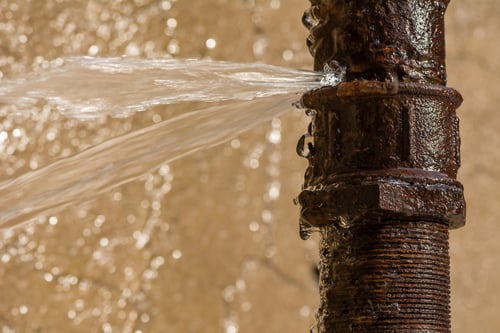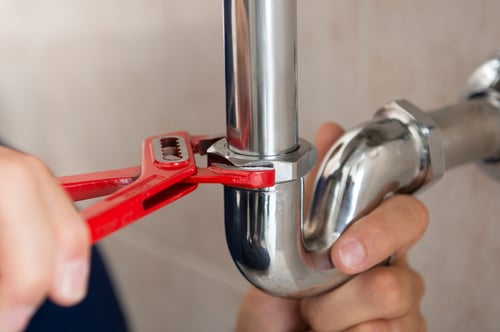Plumbing Tips to Reduce Water and Energy Consumption

Improved water efficiency not only reduces water bills, but also energy expenses - consider that water heating can represent a quarter of the energy consumed in a household. You can conserve water without sacrificing convenience by fixing leaky toilets, installing low-flow showerheads, and collecting rainwater for irrigation. In particular, toilets can account for almost a third of indoor water consumption in an average home.
This article provides a series of plumbing tips that conserve both water and energy, while keeping your plumbing installation under optimal operating conditions.
1) Perform home inspections to find plumbing issues
Plumbing issues can be fixed more easily and for a lower cost if they are detected early, instead of waiting to have a clogged pipe or a broken seal:
- Check sink, bath and shower hardware.
- Inspect exposed pipes below the sink.
- Inspect pipes in your basement and utility room.
- Check toilet leaks by using a few drops of food coloring in the tanks, and checking if the bowl water has changed color 10-15 minutes later. Also check the floor around the toilet, where leaking water could be a sign of a broken seal.
- Check outdoor faucets and hoses.
Once a leak is detected, get the affected pipes and fixtures fixed, or replaced if necessary. Fixing leaky faucets and plumbing joints can save up to 20 gallons per day for each leak. Not all leaks are easily detected, but you can determine if there are hidden leaks by checking your water meter before and after a period of time when no water has been used. If the meter changes, it is likely that there are undetected leaks in your home. If you still can't locate the problems with your plumbing system, then it is highly advised to look for affordable plumbing service providers in your area.

2) Use low-flow fixtures
Low-flow fixtures are a very effective water conservation measure, since you can replace existing fixtures without disturbing the plumbing installation.
- Low-flow showerheads reduce water consumption by over 30% compared with conventional showerheads.
- Low-flow faucets use up to 40% less water than normal faucets.
- Aerators control the maximum flow rate of faucets, and they are inexpensive. This makes them one of the most cost-effective water conservation measures.
- Replace old toilets, which use 5 gallons per flush (gpf), with high efficiency toilets that use no more than 1.6 gpf. Dual-flush toilets have the option of a powerful flush (1.6 gpf) and a standard conservative flush that uses less water (>1 gpf).
If your property uses a water booster pump, low-flow fixtures also reduce electricity consumption by lowering the demand on the pumping system.
3 ) Water heaters play a key role in energy consumption
Since water conservation reduces the volume flowing through water heating systems, it can achieve significant energy savings.
- Replace old water heaters with newer and more energy efficient models.
- Tankless water heaters only heat the water used, reducing energy consumption.
- If using a tank-based water heater, make sure to keep it clean to maintain the performance and efficiency of the heater at optimal levels.
- By keeping your water heater at 120°F or lower, you can prevent scalding while reducing energy expenses - your heater keeps water warm with less energy.
- Insulate pipes to avoid heat losses between the water heater and plumbing fixtures.
4) Check the supply hoses of your washing machine
Washing machines also consume large amounts of water, and leaks affecting them can have a significant impact on your water bills.
- Move the washing machine away from the wall and check the floor for signs of drips and leaks.
- Inspect the water supply hoses from end to end, checking for cracks or other signs of damage - rubber hoses deteriorate with age.
- Replace rubber hoses every five years, or as needed.
5) Develop efficient lawn and garden management practices
- Many property owners focus on indoor water conservation, while ignoring outdoor use. In properties with green areas, outdoor consumption can represent a large portion of the water bill.
- Apply a layer of mulch between 1” and 3” thick around trees and other plants, to reduce evaporation and the need for watering.
- Harvesting rainwater in barrels or other containers, and use it to maintain the landscape.
- Water your lawn wisely - a smart sprinkler controller can save up to 40 gallons per day.
- Water your lawn at dawn to avoid water loss through evaporation.
- Practice xeriscaping, a design approach for landscaping and gardening that minimizes watering needs. Some concepts of xeriscaping are an optimal garden layout, special types of soil that hold water, the use of desert plants, and efficient irrigation.
Irrigation normally represents the greatest consumption of water outdoors. However, some water is wasted due to overwatering, leaks and bad habits in general.
Get a professional inspection of your building's plumbing system.
6) Don’t forget about drains

Drains do not affect water and energy consumption, but they are fundamental for the overall performance of the plumbing system. Water conservation and energy efficiency are great for a plumbing system, but it must also be well drained.
- Drains are usually ignored until they get clogged. Use environmentally friendly drain cleaners to prevent clogging, since chemically infused cleaners can damage pipe.
- In bathrooms, use strainers to keep particles out of drain pipes.
- Keep fats and oils away from your drain pipes - when grease cools, it solidifies on the walls of pipes and causes clogging. Place grease in a heat-resistant container, and when it cools dispose it in the garbage.
- Follow garbage disposal guidelines to avoid damage to drain pipes.
- Don’t flush dental floss, since it bonds with other waste and forms large clumps that block pipes.
Conclusion
Water efficiency projects are often regarded as difficult or expensive by building owners, but actually it’s quite an achievable goal. Although the outdoor water saving potential is high, indoor consumption is an easier starting point - fixing leaks in bathroom fixtures can lead to significant water and energy savings.
The tips and recommendations mentioned above can improve the performance of your plumbing system, saving money by reducing both water and energy consumption.

Anuj Srivastava
Anuj Srivastava is a principal partner at NY Engineers. He is known for his MEP franchise market knowledge. Anuj is currently leading a team of 100+ MEP/FP engineers and has successfully led over 1500 franchise projects in the US.
Join 15,000+ Fellow Architects and Contractors
Get expert engineering tips straight to your inbox. Subscribe to the NY Engineers Blog below.
